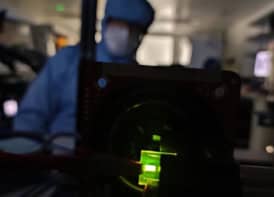Researchers in Australia have shown for the first time that bulk crystalline silicon can be a fairly efficient light emitter. The scientists, led by Martin Green from the University of New South Wales in Sydney, say that the result could allow both optical and electrical functions to be performed on the same silicon chip. Existing optoelectronics devices are made from compound semiconductors such as gallium arsenide or indium phosphide (T Trupke et al. 2003 Appl. Phys. Lett. 82 2996).
Silicon dominates the microelectronics industry but it is not used in optoelectronics applications because it is believed that it does not emit light efficiently. Previous research on improving silicon light emission has focused on porous silicon, nanocrystalline silicon and silicon doped with rare-earth metals such as erbium and cerium.
Green and co-workers excited a variety of commercially available pure silicon wafers using light with a wavelength of 780 nm from a laser diode. They calculated the ‘external’ light emission efficiency by dividing the number of photons emitted by a sample by the number of photons used to excite it. Photons are emitted when electrons that have been photo-excited into the conduction band recombine with ‘holes’in the valence band.
The team calculated that the external light emission efficiency was up to 6.1% at room temperature and up to 10.2 % at 130 K. The researchers then used a theoretical model to predict that the ‘internal’ light efficiency is larger than 20% at room temperature under optimal excitation conditions. The internal light efficiency is the ratio of the number of photons that are spontaneously emitted inside the sample and the total internal recombination rate per unit area.
“The result means that ‘radiative recombination’ can be one of the dominant recombination channels in pure crystalline silicon,” team member Thorsten Trupke told PhysicsWeb. “This is in stark contrast to a widely accepted perception that silicon is an inherently poor light emitter.” The group is now investigating ways to modulate the light emitted by the silicon. It also hopes to improve the surface texture of the samples to further increase efficiency.



